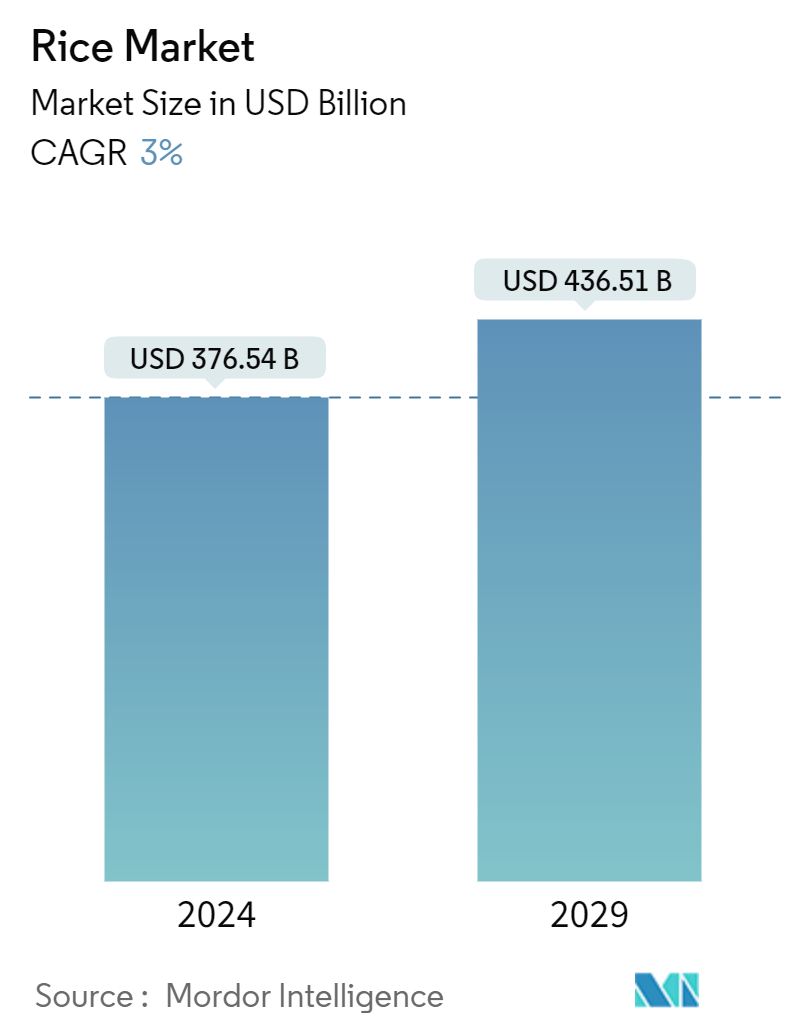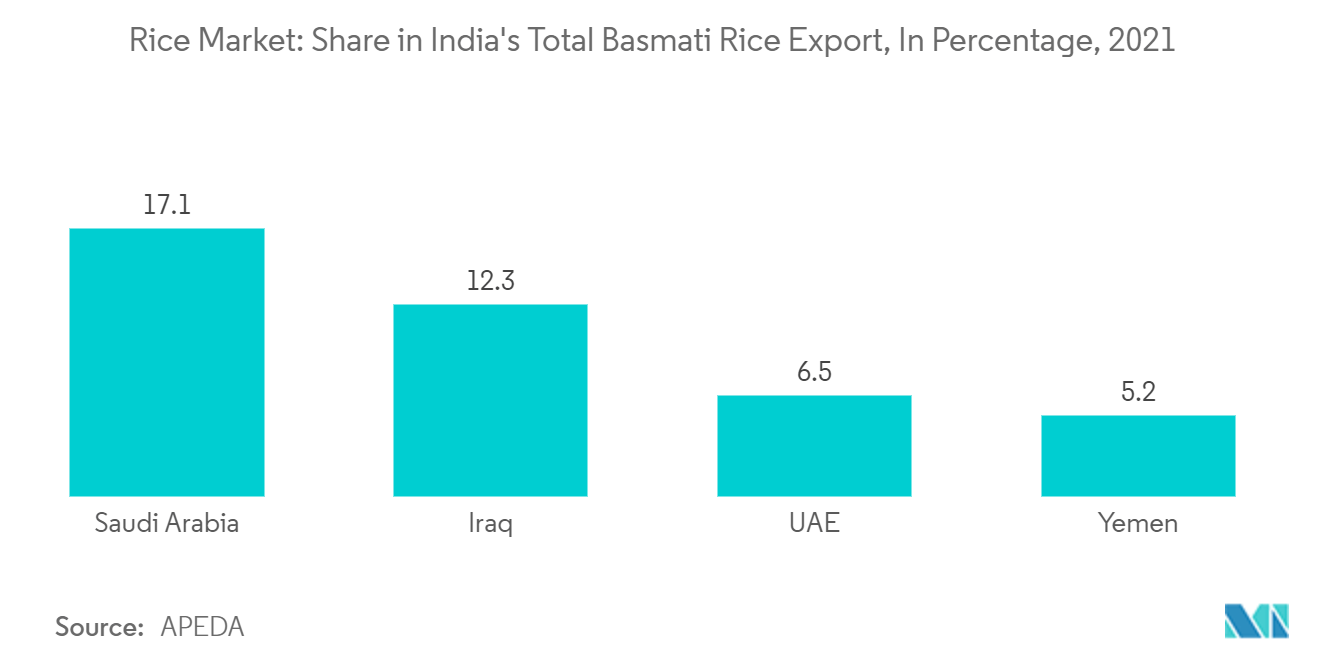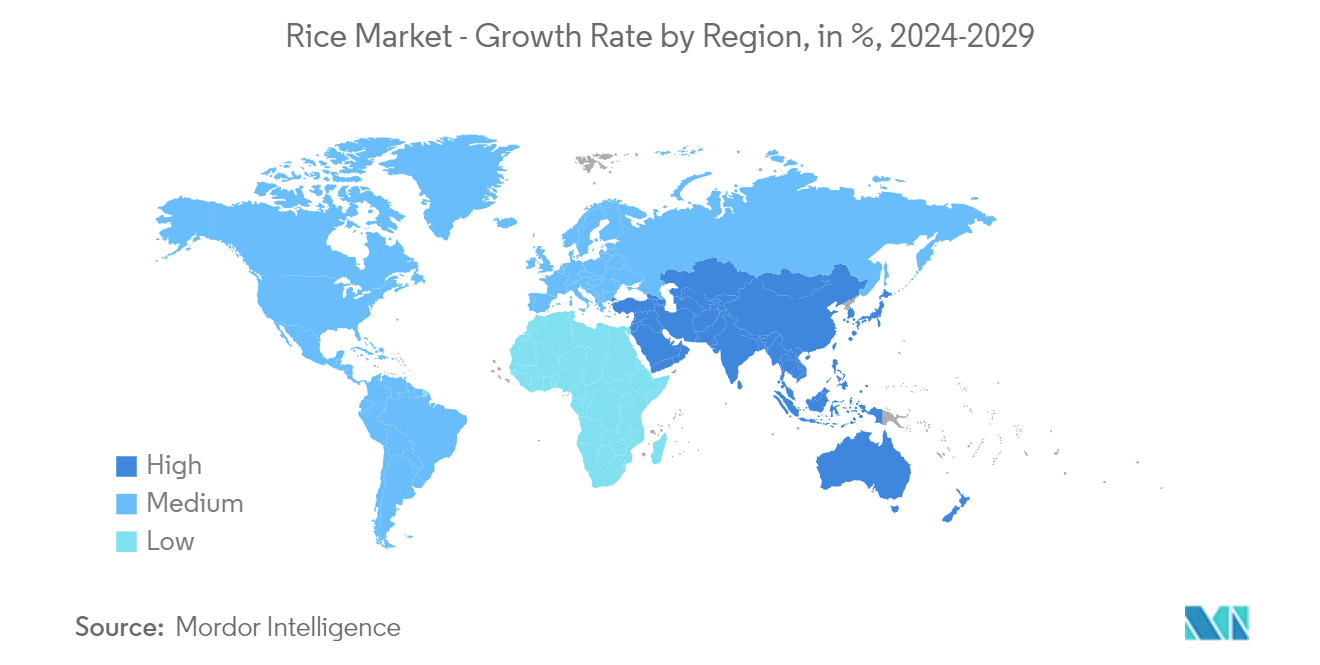Rice Market Size

| Study Period | 2019 - 2029 |
| Market Size (2024) | USD 376.54 Billion |
| Market Size (2029) | USD 436.51 Billion |
| CAGR (2024 - 2029) | 3.00 % |
| Fastest Growing Market | North America |
| Largest Market | Asia-Pacific |
Major Players*Disclaimer: Major Players sorted in no particular order |
Rice Market Analysis
The Rice Market size is estimated at USD 376.54 billion in 2024, and is expected to reach USD 436.51 billion by 2029, growing at a CAGR of 3% during the forecast period (2024-2029).
As a cereal grain, rice is the most widely consumed staple food for most of the global human population, especially in Asia, accounting for nearly 90% of rice production and consumption. Rice is cultivated in more than 120 countries, with China and India accounting for 50% of rice production globally. It is the primary agricultural commodity with the third-highest worldwide production after maize and sugarcane. It is the staple food of more than half of the global population, with the Asian, sub-Saharan African, and South American regions being the largest consumers. For instance, according to the FAOSTAT, the 2022, there were around 165 million hectares of rice-cultivated area worldwide. India was estimated to be the leading global producer of rice and to harvest about 48 million hectares of rice.
The increasing food and restaurant sector is anticipated to promote market growth in the future. Likewise, continuous global development in rice mill machinery and attractive packaging enhance product demand in emerging economies. The rising demand for specialty rice varieties has increased the trade for long-grain rice, which in turn is driving the market growth. Additionally, consumers' constantly changing lifestyles and food habits are accelerating the fast-food industry market, which is expected to drive significant market growth during the forecast period.
Moreover, rice is one of the most economically important food in the world. Therefore, managing rice processing and resulting by products into more sustainable applications are creating a high value for rice industry in recent years. Out of these, milling process is the most important step in rice production because it determines the nutritional, cooking, and sensory qualities of crude rice. Additionally, the byproducts of the rice milling process provides an economic boost for rice producing nations in the region. For instance,the production of rice bran oil, a rice by product is highly concentrated in the region especially in Indonesia, Thailand, Vietnam due to its high production of rice in the region.
In the Southeast Asian countries, 16% of broken rice is produced after milling and it is widely used in the various applications such as in manufacturing of beer in brewer's industry as it provides the raw ingredients needed as substrates for the yeast to ferment and generate alcohol and is highly consumed due to its diverse & softer texture as compared to unbroken rice. In Thailand, broken rice is consumed as part of local cuisine and in Vietnam, it is considered as popular dish with pork. Dagon beer brewed with rice is widely consumed in Myanmar. Many companies like Dagon Beverages Co. Ltd, and Myanmar Brewery are competing in this industry.There is a growing demand for rice from the food processing, brewers, and feed industries, which is supporting the growth of the rice market and the export market. Therefore, this is projected to drive the rice market during the forecast period.
However, the dependency on monsoons, the heavy incidence of pests and diseases, and other factors, like shortage of land and labor, are anticipated to impede the market growth during the forecast period.
Rice Market Trends
Growing preference for specialty rice varieties leads to increased trade
The demand for specialty rice has been gaining traction globally, bolstered by consumers' growing concerns about health and wellness. Compared with regular milled white rice, specialty rice varieties are rich in vitamins and minerals, aid good health, and are good sources of fiber. Therefore, such varieties are witnessing an immense demand among consumers.
Around the world, basmati rice is one of the best types of rice. It is known for its slender, sleek, tapering grains with a unique taste, aroma, and grain elongation quality upon cooking. Exports of the premium variety from India have an 85% share in the basmati export market. The United States imports Asian aromatic rice, such as jasmine and basmati. India is the top exporter of basmati rice to the global market. According to the Agricultural and Processed Food Products Export Development Authority (APEDA), the country exported 3,948,161.03 metric tons of basmati rice to the world for the worth of USD 3,540.40 million during the year 2021-22. In 2021, Saudi Arabia, Iran, Iraq, the United States, and the United Arab Emirates were the major importers of basmati rice.
In 2021, China, the Philippines, the Kingdom of Saudi Arabia, the United States, Bangladesh, and Iraq were the major importers of rice globally. China and the Philippines account for 45% of the rice imports at the global level. India exports huge volumes of aromatic and long-grain basmati rice, which is anticipated to increase with tourism and changes in food patterns. Port handling infrastructure, the value chain development, and exploring new opportunities in countries or markets for rice exports led to a huge spike in rice exports.
In Europe, the demand for specialty and exotic varieties, such as basmati as well as jasmine rice, is growing exponentially. A significant share of imported rice consists of long-grain Indica rice and aromatic varieties (basmati and jasmine), which are popular mainly in Northern Europe. The United Kingdom dominates the imports of basmati rice, mainly from India.
Furthermore, black rice, also known as forbidden rice, an antioxidant-rich variety, has become an exotic staple, which is quickly gaining popularity in North America. The Boston-based Whole Grains Council refers to another study on its site from a team of researchers at the Cornell University, who found that antioxidants were about six times higher in black rice than in common brown and white rice. Thus, the rising demand for different specialty varieties of rice has been significantly bolstering the growth of the rice market across the globe.

Asia-Pacific is the Largest Region
Rice is the staple food of Asia and part of the Pacific. According to the Food and Agriculture Organization, about 90% of the global rice is produced and consumed in Asia. India and China are the prominent producers of rice, with a production of 177.6 million metric tons and 211.4 million metric ton, respectively, in 2020.
Over the ages, China has dominated production and continues to do so. All rice cultivation is highly labor-intensive. Rice farms are mainly located in Central China, accounting for about 49% of Chinese rice production (National Bureau of Statistics of China). Apart from meeting its huge domestic demand, China also exports a significant quantity of rice globally. Major importers of Chinese rice are Ivory Coast, Korea, Egypt, Turkey, and Japan. Rice production will likely remain high during the forecast period, given the high local consumption and global export demands.
Likewise, rice production in India has increased by 3.5 times in the last 60 years. According to the Rice Exporters Association, Indian rice exports touched 20 million tons in 2021, as well as 16 million tons of non-basmati rice. Rice being vital, no country-enforced restrictions on its import. Furthermore, the Indian government has been helping farmers to take up rice cultivation by providing a minimum support price (MSP). For the 2021-2022 Kharif season, the minimum selling price (MSP) was INR 1,940 per quintal compared to INR 1,868 per quintal in 2021.
Rice is highly water intensive crop in India. As a result, various state government are investing on more sustainable method for production. For instance, in 2021 under the umbrella scheme for agriculture development in the country, Rastriya Krishi Vikas Yojna (RKVY) Haryana government initiated direct seeded rice technique, which consume about 15-20% less water than the traditional technique in the country. Farmers following this technique were awarded USD 67.4 per acre. This initiative is anticipated to improve the sustainable production of rice in the country.
In addition, Indonesian Bureau of Logistics (BULOG) manages state interventions in the domestic market and imports, as well as market activities aimed at stabilizing domestic prices and the government rice reserve. BULOG acquire paddy or rice from farmers if the market price is less than or equal to the minimum price, and it must keep a minimum year-end stock of 2 million metric tons, or around 2.5 % of Indonesia's annual rice consumption. Government procuring rice in market failure conditions, encourage farmers for increased production.
After China and India, Indonesia, Bangladesh, Vietnam, and Thailand were the next largest rice producers. Thus, owing to increasing demand and government initiatives to increase rice production, the market is anticipated to grow during the coming year.

Rice Market News
February 2024: India's food ministry launched 'Bharat rice' at a subsidized rate of Rs 29(USD 0.35) per kg to provide relief amid a 15 percent rise in retail prices of grain in the last year.
October 2023: China cultivated genetically modified giant rice in mountainous regions in Beijing to bolster food security amid soaring global rice prices. The yield reached 12.6 metric tons per hectare a 5 percent increase from 12 metric tons per hectare last year.
January 2022: The Tamil Nadu Agricultural University (TNAU) released a new rice variety named 'TRY 5' in India. This is an early-duration variety suited for salt-affected soil.
Rice Market Report - Table of Contents
1. INTRODUCTION
- 1.1 Study Assumptions and Market Definition
- 1.2 Scope of the Study
2. RESEARCH METHODOLOGY
3. EXECUTIVE SUMMARY
4. MARKET DYNAMICS
- 4.1 Market Overview
-
4.2 Market Drivers
- 4.2.1 Rising Demand for Milled and Broken Rice
- 4.2.2 Growing Preference for Speciality Rice Variety
- 4.2.3 Government Initiatives Supports Rice Production
-
4.3 Market Restraints
- 4.3.1 Lack of Supply Chain for Rice
- 4.3.2 Growing Agricultural Labor Crisis
- 4.4 Value Chain Analysis
5. MARKET SEGMENTATION
-
5.1 Geography (Production Analysis, Consumption Analysis, Import Market Analysis by Volume and Value, Export Market Analysis by Volume and Value, and Price Trend Analysis)
- 5.1.1 North America
- 5.1.1.1 United States
- 5.1.1.2 Canada
- 5.1.2 Europe
- 5.1.2.1 Germany
- 5.1.2.2 United Kingdom
- 5.1.2.3 France
- 5.1.2.4 Italy
- 5.1.2.5 Spain
- 5.1.3 Asia-Pacific
- 5.1.3.1 China
- 5.1.3.2 Australia
- 5.1.3.3 India
- 5.1.3.4 Indonesia
- 5.1.3.5 Thailand
- 5.1.3.6 Vietnam
- 5.1.4 South America
- 5.1.4.1 Brazil
- 5.1.4.2 Argentina
- 5.1.5 Middle East and Africa
- 5.1.5.1 South Africa
- 5.1.5.2 Egypt
6. MARKET OPPORTUNITIES AND FUTURE TRENDS
** Subject To AvailablityRice Industry Segmentation
Rice is the staple food of more than half of the global population, with the Asian, Sub-Saharan African, and South American regions being the largest consumers. The global rice market report covers Production Analysis (Volume), Consumption Analysis (Volume and Value), Import Analysis (Volume and Value), Export Analysis (Volume and Value), and Price Trend Analysis across emerging and established markets globally, including major markets in North America, Europe, Asia-Pacific, South America, and the Middle East and Africa. The report offers the market size and forecasts in terms of value in USD and volume in metric tons for all the above segments.
| Geography (Production Analysis, Consumption Analysis, Import Market Analysis by Volume and Value, Export Market Analysis by Volume and Value, and Price Trend Analysis) | North America | United States |
| Canada | ||
| Geography (Production Analysis, Consumption Analysis, Import Market Analysis by Volume and Value, Export Market Analysis by Volume and Value, and Price Trend Analysis) | Europe | Germany |
| United Kingdom | ||
| France | ||
| Italy | ||
| Spain | ||
| Geography (Production Analysis, Consumption Analysis, Import Market Analysis by Volume and Value, Export Market Analysis by Volume and Value, and Price Trend Analysis) | Asia-Pacific | China |
| Australia | ||
| India | ||
| Indonesia | ||
| Thailand | ||
| Vietnam | ||
| Geography (Production Analysis, Consumption Analysis, Import Market Analysis by Volume and Value, Export Market Analysis by Volume and Value, and Price Trend Analysis) | South America | Brazil |
| Argentina | ||
| Geography (Production Analysis, Consumption Analysis, Import Market Analysis by Volume and Value, Export Market Analysis by Volume and Value, and Price Trend Analysis) | Middle East and Africa | South Africa |
| Egypt |
Rice Market Research FAQs
How big is the Rice Market?
The Rice Market size is expected to reach USD 376.54 billion in 2024 and grow at a CAGR of 3% to reach USD 436.51 billion by 2029.
What is the current Rice Market size?
In 2024, the Rice Market size is expected to reach USD 376.54 billion.
Which is the fastest growing region in Rice Market?
North America is estimated to grow at the highest CAGR over the forecast period (2024-2029).
Which region has the biggest share in Rice Market?
In 2024, the Asia-Pacific accounts for the largest market share in Rice Market.
What years does this Rice Market cover, and what was the market size in 2023?
In 2023, the Rice Market size was estimated at USD 365.24 billion. The report covers the Rice Market historical market size for years: 2019, 2020, 2021, 2022 and 2023. The report also forecasts the Rice Market size for years: 2024, 2025, 2026, 2027, 2028 and 2029.
What are the key challenges faced in the Rice Industry?
The key challenges faced in the Rice Industry are a) Competition for water resources for irrigation can limit rice production in some regions b) Global rice prices can fluctuate significantly, affecting producer income and market stability
What are the key challenges faced in the Rice Industry?
The key challenges faced in the Rice Industry are a) Competition for water resources for irrigation can limit rice production in some regions b) Global rice prices can fluctuate significantly, affecting producer income and market stability
Rice Industry Report
The global rice market is on an upward trajectory, fueled by population growth, changing dietary habits, and the expansion of the US food service industry. As a staple in diets worldwide, particularly in the Asia Pacific region, rice's demand is surging, with a notable rise in specialty varieties like aromatic and long-grain rice, appealing to health-conscious consumers and gourmet dining. Technological advancements in milling and packaging are making rice more attractive in emerging markets. The market, dominated by long-grain rice due to its widespread use in homes and food services, is diversifying with medium and short-grain types. While offline stores lead in sales, online platforms are becoming increasingly popular for their convenience and variety. With the rice market poised for further growth, opportunities abound in both established and emerging markets, due to evolving consumer tastes and the development of new rice varieties. This growth is supported by Mordor Intelligence™ Industry Reports, offering insights into market share, size, revenue growth, and forecasts, available for download as a free report PDF, providing a comprehensive overview and future outlook of the rice industry.



